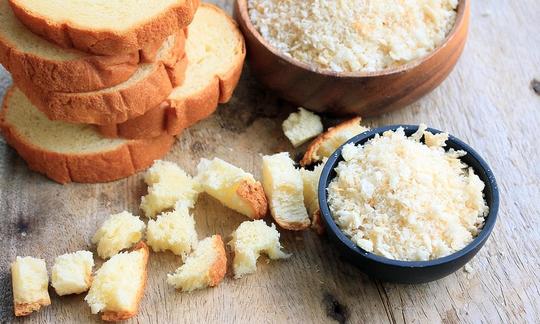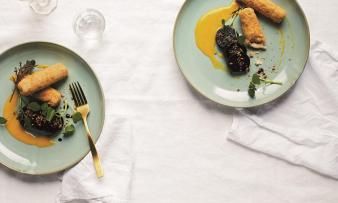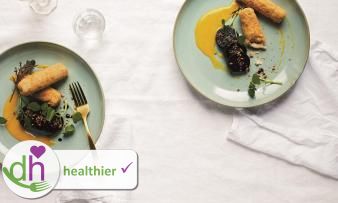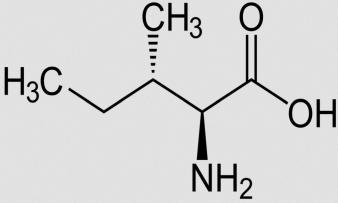Table of contents
Panko, also called panko flour, comes from Japanese cuisine and is the Asian version of traditional breadcrumbs. The flakes are made from crust-free, dried white bread and produce a light and airy coating.
Use in the kitchen
What is panko flour? Panko, which is made from crustless white bread, is the Asian version of classic breadcrumbs. It is made from white flour ( wheat flour), water,yeast and salt. In addition, panko flour sometimes contains other ingredients such as corn starch, shortening, tapioca starch or sugar. Panko is made by grinding already baked bread, which is why it is not raw.
What is the difference between panko and breadcrumbs? The biggest difference is that panko is made from white bread without a crust. It is characterized by its flaky, coarse texture, which creates a particularly crispy and airy crust when fried and baked. Due to the way it is made, panko flour tends to produce a lighter and crispier coating, as the panko flakes do not absorb as much fat.
Panko flour is mainly used in Asian cuisine in countries such as Japan, Korea, Thailand, China and Vietnam. Panko flour is mostly used to bread fish, seafood, chicken and pork. A traditional dish in Japan is Tonkatsu, pork cutlet with panko flour. For a vegan version of the Japanese specialty, you can use soy medallions, celery, kohlrabi ( baked kohlrabi cutlet) or oat flakes.
Another classic where Panko is used is Tempura. In Tempura, fish, seafood and vegetables are coated in a light panko batter and then fried in hot oil (e.g. rapeseed oil). Panko flour gives various types of mushrooms, such as button mushrooms, shiitake mushrooms and oyster mushrooms, as well as vegetables, including broccoli, carrots, sugar snap peas, asparagus, baby zucchini and sprouts, such as mung bean sprouts, a crispy crust.
In traditional recipes, the vegetables are coated in beaten egg and then rubbed with panko. However, the breading also works very well without egg. Alternatively, you can mix flour and water in a ratio of 3:1 to form a thick mixture.
In addition to the classic breading, Panko is ideal for casseroles and gratins, to which it gives a crispy surface. It tastes great as a topping for soups and salads to add extra texture and flavor. In Asian cuisine, Panko is also used as a filling for croquettes and stuffed vegetables, such as eggplant or zucchini.
For a healthier option, you can use whole-grain panko, which contains more fiber. However, you should make sure to use more liquid when using whole-grain panko so that the coating is not too dry. There are also gluten-free panko alternatives that are made from rice flour or other gluten-free flours.
Making your own Panko
Can you make your own Panko breadcrumbs? You can easily make Panko at home. You need white toast or white bread. First, cut the bread into thin slices and remove the crust. Then place the bread slices on a baking tray and dry them in the oven at a low temperature (approx. 100 °C) for about an hour until they are completely dry. Alternatively, you can tear them into coarse flakes and let them air dry for 2-3 days.
The dried bread flakes are then ground in a food processor to form coarse, flaky pieces. It is important not to grind the bread slices too finely in order to maintain the characteristic panko texture. The homemade panko can be stored in an airtight container and will keep for several weeks. For a more wholesome version, panko flour can be made from fine wholemeal bread.
You can bake your own Panko bread using the following typical ingredients: 400 g wheat flour (type 550), 100 g corn starch, 50 g tapioca starch, palm oil ( rapeseed oil is also suitable as an alternative), a packetof dry yeast and 250 ml of water at room temperature. It is best to follow the preparation steps of a classic bread recipe.
Vegan recipe for kohlrabi schnitzel
Ingredients : 1-2 small kohlrabi, plant milk (e.g. oat drink), panko, corn starch, spelt flour,sunflower oil.
Preparation : Peel the kohlrabi and cut into finger-thick slices. You can shorten the frying time by blanching it briefly, about 5 minutes in boiling water. Then put some plant milk in a bowl and 2 tablespoons of spelt flour and 2 tablespoons of starch in a plate. Also prepare an additional plate with about 3 tablespoons of panko. If you don't have a deep fryer, you can fill a small saucepan with sunflower oil so that the oil is about 3-4 cm high.
First, dip the kohlrabi slices in plant milk, then turn them in the flour-starch mixture and moisten them again with milk. Finally, coat the schnitzels in panko and fry them in sunflower oil until they are golden brown. Serve with salad or chutney.
Vegan recipes with Panko can be found under the note: " Recipes that have the most of this ingredient ".
| Not only vegans or vegetarians should read this: Vegans often eat unhealthily. Avoidable nutritional errors. |
Purchasing - Storage
Where can you buy Panko flour? You can definitely find Panko in online shops and in Asian food markets. In Japan, Panko flour can be bought in all supermarkets, while in Europe only some supermarkets stock it. You can get the Japanese breadcrumbs all year round at Migros, Rewe, Edeka, Billa and Spar. Supermarkets such as Coop, Denner, Volg, Aldi, Lidl, Hofer etc. rarely stock it and if they do, then only as special offers. Organic quality can be found in health food stores and organic supermarkets such as Denn's Biomarkt and Alnatura as well as online shops.
You can also buy panko flour made from wholemeal bread. Gluten-free panko made from rice flour or other gluten-free flours is rarely available. However, you can make it yourself from gluten-free bread. Panko flour is also available in a fresh version, called Nama Panko. It contains a residual moisture content of around 30%. 17
When buying panko, you should check the ingredients list to make sure it is vegan panko flour free of preservatives or emulsifiers. Unlike breadcrumbs, which can be bought seasoned, the Japanese variety usually does not contain any additional seasonings. The ingredients are usually very simple and only include white flour, water, yeast and salt.
The availability of panko flour varies depending on the size of the store, catchment area, etc. Our recorded food prices for the DA-CH countries can be found above under the ingredient image - and by clicking you can see their development at various suppliers.
Storage tips
Panko should be stored in a dry, airtight container to prevent it from spoiling due to humidity. The contents of opened packages should therefore be placed in an airtight container. Homemade Panko flour can also be frozen in a container and used when needed.
Ingredients - Nutritional values - Calories
What ingredients does panko flour contain? The energy content of panko flour is 358 kcal/100g. The macronutrients are divided into 79 g carbohydrates, 10 g protein and 2.1 g fat per 100 g. The high carbohydrate content of panko crumbs consists of 4.4 g sugar and 5.3 gfiber. The high salt content is striking at 711 mg/100g. With a recommended daily amount of 6 g salt, this corresponds to 29.6%. 1
280 mg of the salt content is due to the sodium content. This corresponds to about 35% of the recommended daily allowance, which is a lot. In ordinary breadcrumbs, the sodium content is much higher: it is 400 mg/100g. 1
100 g of panko flour contains around 0.1 g of tryptophan, which is 41% of the daily requirement. Classic breadcrumbs contain the same amount of the amino acid. Sunflower seeds with 0.35 g/100g and wheat germ with 0.32 g/100g have 3 times as much of the amino acid. Soybeans and hemp seeds contain 6 times as much tryptophan with 0.59 g/100g and 0.61 g/100g respectively. 1
Threonine is contained at 0.3 g/100g. This covers 32% of the daily requirement. Oatmeal has slightly more threonine at 0.38 g/100g. Almonds and walnuts contain twice as much at 0.6 g/100g each.Pumpkin seeds are particularly rich sources at 1 g/100g and hemp seeds at 1.3 g/100g. 1
You can find all the ingredients of Panko flour, the coverage of the daily requirement and comparison values with other ingredients in our nutrient tables. In the article Nutrients explained you will get a detailed insight into the topic.
Health Effects
Questions like Is Panko healthy? or Is Panko flour healthier than breadcrumbs? can be answered as follows: Both breadcrumbs and Panko flour are products that have no health benefits. They are mainly processed foods that are used to enrich taste and texture rather than for their nutritional properties.
Panko flour is made from white bread, which has little nutritional value. It is high in calories and contains mainly carbohydrates. At the same time, panko has little to no significant amounts offiber, protein, vitamins or minerals. 1 It should therefore only be consumed occasionally.
The glycemic index (GI) of white flour is 85, which is very high. A low GI value is typically below 55, while foods with a GI above 70 are considered high. 2 High GI foods are particularly problematic for people with diabetes or insulin resistance, as they cause a rapid increase in blood sugar levels. 3
Studies show that a diet with a high glycemic index (GI) increases the risk of diseases such as obesity (in women), type 2 diabetes mellitus, coronary heart disease (in women) and colon cancer. An EPIC study was able to demonstrate that there is a connection between a high GI and the risk of abdominal obesity (visceral obesity). 3
The ingredients vary depending on the manufacturer, with wheat flour, fat (butter or hydrogenated palm fat),yeast and table salt being the basic ingredients. The addition of other ingredients such as corn starch, modified tapioca starch and sugar is possible. The salt and fat contained are ingredients that have a negative effect on our health if consumed in excessive quantities. 4 If you absolutely need panko flour for cooking, it is important to use milk-, egg- and fat-free products from organic production.
Fried foods contain large amounts of oil and are very high in calories. Studies show that frequent consumption promotes heart disease and cancer. Fried foods also have a negative effect on blood sugar levels. 5 Especially in combination with a lot of salt, daily consumption of fried foods, especially meat and fish, is responsible for an increased risk of developing cardiovascular disease. 6
Secondary plant substances
Secondary plant substances are not relevant to the nutrient profile of panko flour. Find out more about the importance and classification of these bioactive substances in foods in the article on secondary plant substances.
Dangers - Intolerances - Side effects
Is Panko gluten-free? No, because Panko is made almost exclusively from wheat bread and wheat contains the allergen gluten. Panko is therefore unsuitable for people with gluten intolerance (celiac disease). The symptoms vary from mild stomach pain to diarrhea, constipation, flatulence, vomiting, as well as skin changes, headaches or migraines. 7
People who are allergic to wheat should also avoid eating panko. In affected people, wheat products trigger an immune reaction in which the body produces IgE antibodies against the wheat protein. This can lead to skin rashes, gastrointestinal complaints, respiratory problems and, in severe cases, even anaphylactic reactions. 8
Although panko flour contains around 40% less salt than regular breadcrumbs, you should still keep an eye on it, as you can easily exceed the daily guideline. According to the WHO ( World Health Organization), the value for healthy adults is 2 g of sodium or 5 g of salt per day. For comparison: a level teaspoon of salt weighs around 5 g. 9
Excessive salt consumption has a negative impact on our health and can cause cardiovascular diseases and Cause high blood pressure. 10 For more detailed information and ways to reduce your salt intake, see the articles on salt and sea salt. When buying panko, check the ingredients list and choose varieties with less salt if a low-salt diet is required. Alternatively, you can use homemade panko flour with no added salt.
High temperatures are used when frying: During the Maillard reaction, prolonged heat of over 120 °C (frying or roasting) can produce harmful substances such as HMF (hydroxymethylfurfural), furfural and acrylamide. These are suspected of being carcinogenic. When preparing foods that contain panko, please note: the darker the crust, the more acrylamide has formed. 11
Ecological footprint - animal welfare
The ecological footprint of a food depends on various factors. The type of agricultural production (conventional vs. organic), seasonal, regional, domestic production or import by truck, ship or plane, different types of packaging and whether the goods are fresh or frozen all play a decisive role. 12
The Swedish website Carboncloud puts the carbon footprint of panko flour from the USA at 2.05 kg CO 2 eq/kg. 13 For comparison: For breadcrumbs, the value is 1.5-1.85 kg CO 2 eq/kg. 14,15 In 2019, the Institute for Energy and Environmental Research Heidelberg ( IFEU) examined almost 200 foods in Germany for their environmental impact. White bread produces emissions of 0.7 kg CO 2 eq/kg and for fine baked goods the value is 1.6 kg CO 2 eq/kg. 12
We do not have exact figures for the water footprint of panko flour. However, we found a value of 1608 l/kg for white bread. 16 Since panko is often made from dried bread and goes through similar manufacturing processes, one can expect a similar magnitude for water consumption. The actual water footprint of panko flour can vary depending on the manufacturing method, the origin and type of grain, and other factors.
For information on the ecological impact of wheat cultivation, see the ingredient wheat flour.
For detailed explanations of various sustainability indicators (such as ecological footprint, CO2 footprint, water footprint), see our article: What does the ecological footprint mean?
Worldwide occurrence - cultivation
Panko flour originates from Japan and was created in the 1970s. Today it is known and represented worldwide. 17
Industrial production
The bread used for panko flour is not made using the traditional oven-baking method, but using a process that uses electric current. In so-called dielectric baking, the bread is heated directly using electric current that is passed through the dough. This creates heat. The flow of electricity heats the dough so quickly that no browning crust is formed. 17
In order to pass the current through the dough, the right recipe with a special flour mixture and a certain salt content is required. If the salt content is insufficient, the dough will remain raw, while a higher salt content will cause the loaf to overbake (burn). After baking, the crumbs are crushed, dried and sorted according to grain size. 17
Further information
There are different types of breading: On the one hand, there are flour-based breadings, and on the other hand, there are traditional breadcrumbs, known as American Bread Crumb or Home Style Bread Crumb, which are made from grated white bread. Cracker Meal is made from crushed crackers. It has a finer texture than normal breadcrumbs. Panko is the Asian, crust-free version of classic breadcrumbs and provides a lighter crust. 17
The "mie de pain" known in the West is very similar to panko flour, as it is also made from white bread without the crust. Unlike panko, however, this variant is finer and fresh, not dried.
Alternative names
What is Panko in German? The word comes from Japanese (パン粉) and means bread flour in German.
Other names for panko are pano flour, Japanese breadcrumbs or tempura flour. In English it is called Japanese bread crumbs, panko bread crumbs or crispy bread crumbs.
Bibliography - 17 Sources (Link to the evidence)
| 1. | USDA (United States Department of Agriculture). Nährwerttabellen. |
| 2. | GI-Handbuch NR. 1 (online). Glykämischer Index von Getreide. 2024 |
| 3. | Verbraucherzentrale: Glykämischer Index (GI) und Glykämische Last (GL). 2023. |
| 4. | BZfE Bundeszentrum für Ernährung. Zu viel Zucker, Fette und Salz können krank machen. 2023. |
| 5. | Sun Y, Liu B et al. Association of fried food consumption with all cause, cardiovascular, and cancer mortality: prospective cohort study. British Medical Journal. 2019;364:k5420. |
| 6. | Gadiraju TV, Patel Y et al. Fried Food Consumption and Cardiovascular Health: A Review of Current Evidence. Nutrients. 2015;7(10):8424–8430. |
| 7. | Öffentliches Gesundheitsportal Österreichs: Zöliakie. 2023. |
| 8. | Öffentliches Gesundheitsportal Österreichs: Allergie auf Getreide. 2023. |
| 9. | WHO World Health Organization. Sodium reduction. 2023. |
| 10. | Agócs R, Sugár D, Szabó AJ. Is too much salt harmful? Yes. Pediatr Nephrol. 2020;35(9):1777–1785. |
| 11. | BLV Bundesamt für Lebensmittelsicherheit und Veterinärwesen. Acrylamid. 2020. |
| 12. | Reinhardt G, Gärtner S, Wagner T. Ökologische Fussabdrücke von Lebensmitteln und Gerichten in Deutschland. IFEU Institut für Energie - und Umweltforschung Heidelberg. 2020. |
| 13. | Carboncloud. PANKO CRISPY BREAD CRUMBS, PLAIN. 2024. |
| 14. | The Big Climata Database. Bread-crumbs. 2024. |
| 15. | Carboncloud. Bread crumbs. 2024. |
| 16. | Mekonnen MM, Hoekstra AY. The green, blue and grey water footprint of crops and derived crop products. Hydrol. Earth Syst. Sci. 2011;15:1577-1600. |
| 17. | Perera C, Embuscado ME. Texture design for breaded and battered foods. In: Food Texture Design and Optimization. John Wiley & Sons, Ltd; 2014. S. 128–158. |










Comments